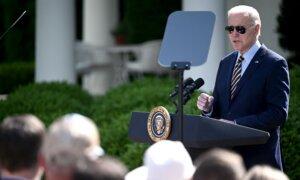President Joe Biden is sabotaging his own success in reviving domestic manufacturing by entangling the nation’s electric grid in regulatory red tape, a May 21 Senate hearing was told.
With power demand poised to triple in coming decades, panelists and witnesses said they call on the administration to accede to “so, so desperate” calls for permitting reform.
“We can’t be open for business if we can’t keep the lights on,” Senate Natural Resources Committee Chair Sen. Joe Manchin (D-W.Va.) said.
“If America can’t build the energy infrastructure needed to support these industries with reliable affordable power, we will be forfeiting the opportunity to be on the forefront of technologies of the future and cede control to China.
“And right now,” he added, “between the administration’s policies and our inability to act in Congress, it seems like we may be in real danger of doing just that.”
Sens. John Barrasso (R-Wyo.), James Risch (R-Idaho), and Catherine Cortez Masto (D-Colo.) joined Mr. Manchin in praising Mr. Biden during the two-hour hearing for stimulating energy demand through 2021’s Bipartisan Infrastructure Law (BIL) and 2022’s CHIPS & Science and Inflation Reduction (IRA) acts, and then chastised the administration for undercutting those very gains with environmental policies.
Under Mr. Biden’s 30-percent tax credit for “clean energy” development, nearly $650 billion in private capital has been invested in U.S.-based manufacturing, including $120 billion in battery factories and $35 billion in electric vehicle (EV) plants, creating more than 275,000 jobs in the past 18 months.
With more than 600 projects advancing, NAM documents construction spending in manufacturing nearly tripled since June 2020 and was up 37 percent year-over-year in January 2024 when it reached a record-high of $225 billion.
Energy usage just by the industrial sector, propelled by data centers using artificial intelligence (AI), is projected to grow 36 gigawatts by 2030, according to the North American Electric Reliability Corporation (NERC), the equivalent of powering 25 million homes.
Many utilities fear a disconnect between projected demand and the administration’s new Environmental Protection Agency (EPA) power plant rules, liquid natural gas (LNG) export pause, “obstructions” in public lands leasing, and creation of 70 regulatory regimes critics say have contributed to a 30-percent hike in electricity costs since 2021.
The new EPA rules require coal plants to reduce greenhouse gas emissions by 90 percent by 2039 or close.
There are about 200 coal-burning power plants in the United States that generate about 16 percent of the nation’s electricity that could be retired “prematurely” under the rules.

Inexplicable EPA Rules
Mr. Manchin said the Federal Energy Regulatory Commission (FERC) and NERC say “our grid’s reliability and affordability are at risk because we are retiring base-load dispatchable generation faster than we can replace it” and even when doing so, it’s with wind and solar, “intermittent power” that doesn’t provide certainty or cost-savings.He called EPA’s power plant rules inexplicable.
“As far as I can tell, they aim to kill coal completely and stop natural gas from replacing it. It’s a double whammy,” he said, noting there are 2.6 million megawatt hours of generation “waiting an average of five years to connect” to the grid.
“Think about that—2.6 million megawatt hours waiting with nowhere to go,” he continued. “If we’re serious about on-shoring critical industry, we shouldn’t be in a race to take power offline.
“We should be racing to bring new generation on. But instead, it’s getting harder to build new energy infrastructure and connect new generation to the grid.”
The EPA rules “will force the premature closure of even more coal- and natural gas-fired power plants” needed for ensuring electric reliability and affordability, Mr. Barrasso said.
“President Biden doesn’t seem to care at all. He wants to force operators to shut down these plants before the end of their useful life,” he said.
“It is a disgrace. We cannot regulate our way to more electric generation.”
Mr. Barasso said China has added 262 gigawatts of coal-fired electric generation since 2020 while U.S. utilities have “shut down” more than 100 gigawatts of coal-fired electric power.
“Whoever secures affordable and reliable electric power—China or America—will have a big head start in the race for artificial intelligence,” he said.
“And right now, America is not positioned well. Our grid is already strained.”
Electricity Consumers Resource Council (ELCON) CEO/President Karen Onaran said while “the manufacturing resurgence is providing tremendous benefits and opportunities for economic growth,” it is uncertain if U.S. utilities can expand rapidly enough to meet demand without “all-of-the-above” energy generation.

All Agree: All-Of-The-Above
American Electric Power Co. (AEPC) CEO/President Ben Fowke estimated the “capital cost of renewables and natural gas generation” to replace power now generated by 200 “prematurely retired” coal plants “could exceed $300 billion.”“AEP currently has requests from large customers that would more than double the existing peak demand we serve on our system today,” Mr. Fowke said.
Meeting that demand won’t happen without “a balanced and diversified mix of dispatchable and renewable generation resources that support grid reliability, customer affordability, and environmental sustainability,” he said.
They also called on Congress to establish a central FERC authority focused on reliability, “fast-track” interconnection applications, encourage “next generation” nuclear power, support FERC’s new transmission guidelines, and maintain BIL, CHIPS, and IRA “technology-neutral and nuclear tax credits.”
“It is inevitable that something so crucial to our economy and way of life would be subject to challenges and differing opinions. But we cannot afford to let the perfect be the enemy of the good,” Ms. Onaran said, “strongly encouraging” Congress to pass “permitting reform to reduce the long and often unsurmountable study requirements and misguided opposition from regulatory authorities.”
She said ELCON supports the proposed Expediting Generator Interconnection Procedures Act, HR 8085, co-sponsored by Ms. Cortez Masto (D-Nev.) and Rep. Cathy Castor (D-Fla.), which would allow “FERC to take more aggressive reforms to ease interconnection backlogs, increase reliability, and lower energy costs.”
There are two bottlenecks Congress can address, Mr. Gatzemeier said. “The U.S. government needs to make sure it can permit both the power generation and the power transmission facilities required to meet this demand.
“To be frank,” he added, “I’m worried the United States is not on track to permit those facilities, based on the experience I have seen.”
Mr. Manchin said he and Mr. Barrasso will take action since the administration won’t.
“Permitting and transmission legislation is not partisan priority” but a national urgency, he said.
“There are critical permitting problems for all types of energy infrastructure that only Congress can fix. We finally have language we want to start sharing … so people can see where we are and, hopefully, maybe, we can all get our act together.”
Now, there’s some energy rarely felt on Capitol Hill these days, Mr. Mills said.
“It’s music to my ears to hear such bipartisan convergence on such a critical issue,” he said.







